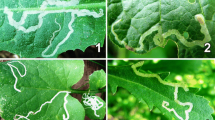Abstract
A mycosis was detected in Symphoromyia hirta (Diptera: Rhagionidae) collected near Ithaca, New York. Other dipterous victims of the disease included Rhagio mystaceus and Empis obesa. Afflicted flies, found on the under surfaces of leaves of woody plants, were affixed to the substrate by rhizoids. The pathogen formed both resting spores and conidia on the exterior of the cadavers. It grew rapidly and sporulated abundantly in culture. Attempts to induce infections in Musca domestica and Aedes aegypti were unsuccessful. The pathogen Erynia ithacensis sp. n. forms resting spores that are incised with very irregular ridges. This characteristic serves to separate it from other dipterophilic species of Erynia.
Similar content being viewed by others
References
Harwood, R. F. & James, M. T., 1979. Snipe flies and arthericids. In ‘Entomology in Human and Animal Health’ 7th ed., pp. 245–246. Macmillan Pub. Co., New York.
Jamnback, H., 1969. Rhagionidae, Symphoromyia (The snipe flies). In ‘Bloodsucking flies and other outdoor nuisance arthropods of New York State’ p. 33. Memoir 19, State Museum and Science Service, State Education Department, Albany, New York.
Kramer, J. P., 1980. The house-fly mycosis caused by Entomophthora muscae: Influence of relative humidity on infectivity and conidial germination. J. New York Entomol. Soc. 88: 236–240.
Müller-Kögler, E., 1959. Zur Isolierung und Kultur insektenpathogener Entomophthoraceen. Entomophaga 4: 261–274.
Pechuman, L. L., 1980. Personal communication.
Remaudiere, G. & Hennebert, G. L., 1980. Revision systematique de Entomophthora aphidis Hoffm. in Fres. description de deux nouveaux pathogenes d'aphides. Mycotaxon 11: 269–321.
Remaudiere, G. & Keller, S., 1980. Revision systematique des genres d'entomophthoraceae a potentialite entomopathogene. Mycotaxon 11: 323–338.
Srinivasan, M. C, Narasimhan, M. J. &Thirumalachar, M. H., 1964. Artificial culture of Entomophthora muscae and morphological aspects for differentiation of the genera Entomophthora and Conidiobolus. Mycologia 56: 683–691.
Turner, W. J., 1979. A case of severe human allergic reaction to bites of Symphoromyia (Diptera: Rhagionidae). J. Med. Entomol. 15: 138–139.
Author information
Authors and Affiliations
Additional information
This study was supported in part by the UNDP/World Bank/WHO Special Programme for Research in Tropical Diseases.
Rights and permissions
About this article
Cite this article
Kramer, J.P. A mycosis of the blood-sucking snipe fly symphoromyia hirta caused by Erynia ithacensis sp.n. (Entomophthoraceae). Mycopathologia 75, 159–164 (1981). https://doi.org/10.1007/BF00482810
Issue Date:
DOI: https://doi.org/10.1007/BF00482810




